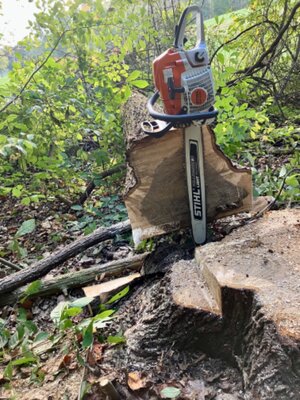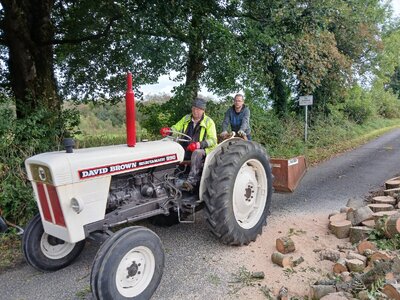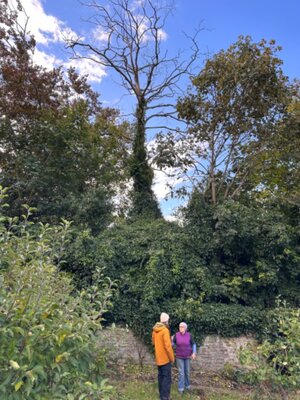You are using an out of date browser. It may not display this or other websites correctly.
You should upgrade or use an alternative browser.
You should upgrade or use an alternative browser.
Trees you've cut
- Thread starter huskyboy
- Start date
TheDarkLordChinChin
My name Borat, I like you
- Local time
- 10:19 AM
- User ID
- 11620
- Joined
- Feb 2, 2020
- Messages
- 577
- Reaction score
- 3,157
- Location
- Ireland
It's hard to tell from the photos but if your'e taking down half or more of the tree in one piece you need to be very careful. If the top hits the ground before the hinge breaks your'e in trouble. You probably know this already but I thought I should tell you anyways because I never thought of it myself until someone told me. As far as I was concerned I was just felling trees while tied in to themI'm not gonna recount all the decisions that led to me doing this, but on Sunday I got to have the honor of knocking down this digger pine for my brother. There were a few major limbs that had to be taken down first, then I scooted down and dropped the spar while my brother hydraulically assisted with the mini ex. Kinda fun, kinda terrifying, I still need more practice/training in the proper ways of doing things but all in all I'd say it was a success.
View attachment 433634View attachment 433635View attachment 433636View attachment 433638
Woodslasher
Teh debil
- Local time
- 2:19 AM
- User ID
- 15993
- Joined
- Mar 18, 2021
- Messages
- 3,682
- Reaction score
- 15,083
- Location
- Commiefornia
I did keep that in mind (as I was all to aware that could be the 2nd to last thing to go through my mind, the butt of a log being the last thing) and consulted a pro buddy before I even touched the tree. In this poor quality screenshot of a video my brother took you can see the thing's free n clear before it gets close to touching the ground.It's hard to tell from the photos but if your'e taking down half or more of the tree in one piece you need to be very careful. If the top hits the ground before the hinge breaks your'e in trouble. You probably know this already but I thought I should tell you anyways because I never thought of it myself until someone told me. As far as I was concerned I was just felling trees while tied in to them

TheDarkLordChinChin
My name Borat, I like you
- Local time
- 10:19 AM
- User ID
- 11620
- Joined
- Feb 2, 2020
- Messages
- 577
- Reaction score
- 3,157
- Location
- Ireland
TheDarkLordChinChin
My name Borat, I like you
- Local time
- 10:19 AM
- User ID
- 11620
- Joined
- Feb 2, 2020
- Messages
- 577
- Reaction score
- 3,157
- Location
- Ireland
Catfishclark89
Super OPE Member
- Local time
- 4:19 AM
- User ID
- 27079
- Joined
- Jul 9, 2023
- Messages
- 422
- Reaction score
- 1,107
- Location
- Glasgow, KY, USA
TheDarkLordChinChin
My name Borat, I like you
- Local time
- 10:19 AM
- User ID
- 11620
- Joined
- Feb 2, 2020
- Messages
- 577
- Reaction score
- 3,157
- Location
- Ireland
- Local time
- 4:19 AM
- User ID
- 22384
- Joined
- Jan 22, 2022
- Messages
- 4,418
- Reaction score
- 32,784
- Location
- MO USA
Interesting.....The "split level" cut.
Was taught it when I did my chainsaw tickets. Never really use it, just as handy to do back cut first with wedges.
View attachment 434588View attachment 434589
That would be useful when wedging smaller trees.
Looks like you done it right.
HumBurner
Pinnacle OPE Member
- Local time
- 2:19 AM
- User ID
- 23235
- Joined
- Apr 19, 2022
- Messages
- 1,146
- Reaction score
- 3,542
- Location
- Humboldt
I'm assuming this is used in a similar fashion as when either undercutting/undermining the undercut OR nipping the holding wood/hinge to twist/turn the tree (specifically for humboldts, but the latter also applies to standard cuts)......??The "split level" cut.
Was taught it when I did my chainsaw tickets. Never really use it, just as handy to do back cut first with wedges.
View attachment 434588View attachment 434589
There's also snipes and Dutchman. I do use a step cut (like what you did) similarly to a snipe when cutting stumps to aid in the direction or speed of fall and encourage it to slide. Especially if I might not put a face in the stump.
TheDarkLordChinChin
My name Borat, I like you
- Local time
- 10:19 AM
- User ID
- 11620
- Joined
- Feb 2, 2020
- Messages
- 577
- Reaction score
- 3,157
- Location
- Ireland
I'm assuming this is used in a similar fashion as when either undercutting/undermining the undercut OR nipping the holding wood/hinge to twist/turn the tree (specifically for humboldts, but the latter also applies to standard cuts)......??
There's also snipes and Dutchman. I do use a step cut (like what you did) similarly to a snipe when cutting stumps to aid in the direction or speed of fall and encourage it to slide. Especially if I might not put a face in the stump.
No it's used to fell a backward leaning tree.
The idea is the tree is too small for your bar and felling wedge to fit into the back cut at the same time.
What you do is make your face cut like normal. Then you cut 2/3-3/4 of your back cut, not cutting the whole way across the trunk. With that done you insert your felling lever into the partially made back cut. The tree cannot sit back at this point because there us still a large portion of timber un cut.
You then cut the rest of your back cut, coming in just below the previous section.
At this point your back cut is complete and you can lever the tree over.
It only works on small trees
HumBurner
Pinnacle OPE Member
- Local time
- 2:19 AM
- User ID
- 23235
- Joined
- Apr 19, 2022
- Messages
- 1,146
- Reaction score
- 3,542
- Location
- Humboldt
Interesting!No it's used to fell a backward leaning tree.
The idea is the tree is too small for your bar and felling wedge to fit into the back cut at the same time.
What you do is make your face cut like normal. Then you cut 2/3-3/4 of your back cut, not cutting the whole way across the trunk. With that done you insert your felling lever into the partially made back cut. The tree cannot sit back at this point because there us still a large portion of timber un cut.
You then cut the rest of your back cut, coming in just below the previous section.
At this point your back cut is complete and you can lever the tree over.
It only works on small trees
I'll give the video a watch. Makes sense for small trees with no room to wedge or prewedge.
Thanks
TheDarkLordChinChin
My name Borat, I like you
- Local time
- 10:19 AM
- User ID
- 11620
- Joined
- Feb 2, 2020
- Messages
- 577
- Reaction score
- 3,157
- Location
- Ireland
It's a neat little trick but like I said this was the first time I have used it since learning it.Interesting!
I'll give the video a watch. Makes sense for small trees with no room to wedge or prewedge.
Thanks
Most of the time the trees you would use this technique on are light enough to just push over. Or you can just back cut first.
TheDarkLordChinChin
My name Borat, I like you
- Local time
- 10:19 AM
- User ID
- 11620
- Joined
- Feb 2, 2020
- Messages
- 577
- Reaction score
- 3,157
- Location
- Ireland
- Local time
- 2:19 AM
- User ID
- 5156
- Joined
- Jan 24, 2018
- Messages
- 9,557
- Reaction score
- 37,841
- Location
- Extreme Southeast CA
I used the stepped back cut or quarter cut on this spar because the lean was to where my wedge is. Taller than usual wedge (forester?) and plunged thru (gutted) the hinge in case the wedge needed driven deep to overcome the back lean. I think I took a little too much off the hinge post on the right, but it was tough Doug fir.


TheDarkLordChinChin
My name Borat, I like you
- Local time
- 10:19 AM
- User ID
- 11620
- Joined
- Feb 2, 2020
- Messages
- 577
- Reaction score
- 3,157
- Location
- Ireland
I had never thought of gutting the hinge to be able to drive the wedge further, that's a good one.I used the stepped back cut or quarter cut on this spar because the lean was to where my wedge is. Taller than usual wedge (forester?) and plunged thru (gutted) the hinge in case the wedge needed driven deep to overcome the back lean. I think I took a little too much off the hinge post on the right, but it was tough Doug fir.
View attachment 435176
TheDarkLordChinChin
My name Borat, I like you
- Local time
- 10:19 AM
- User ID
- 11620
- Joined
- Feb 2, 2020
- Messages
- 577
- Reaction score
- 3,157
- Location
- Ireland
Wonkydonkey
Plastic member
- Local time
- 10:19 AM
- User ID
- 3189
- Joined
- May 14, 2017
- Messages
- 5,433
- Reaction score
- 25,113
- Location
- Sussex, UK.
woodfarmer
Pinnacle OPE Member
- Local time
- 5:19 AM
- User ID
- 5113
- Joined
- Jan 20, 2018
- Messages
- 562
- Reaction score
- 2,040
- Location
- Bowmanville, On, Can
That was the first tractor my uncle bought when he took over the farm from my Grandpa in ‘64. It too still runs to this day.There's a rotten tree for you. Ash. Despite the rot, the outer layer of the first ten feet of this tree was like iron, my climbing spikes would hardly go in.
View attachment 435216
The landowner came out to help with his fully restored David Brown 990
View attachment 435217
TheDarkLordChinChin
My name Borat, I like you
- Local time
- 10:19 AM
- User ID
- 11620
- Joined
- Feb 2, 2020
- Messages
- 577
- Reaction score
- 3,157
- Location
- Ireland
TheDarkLordChinChin
My name Borat, I like you
- Local time
- 10:19 AM
- User ID
- 11620
- Joined
- Feb 2, 2020
- Messages
- 577
- Reaction score
- 3,157
- Location
- Ireland
Similar threads
- Replies
- 9
- Views
- 367
- Replies
- 4
- Views
- 752
- Replies
- 38
- Views
- 2K





























